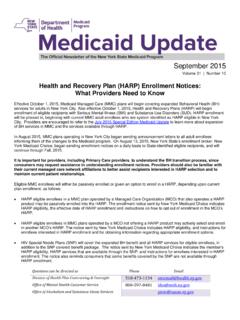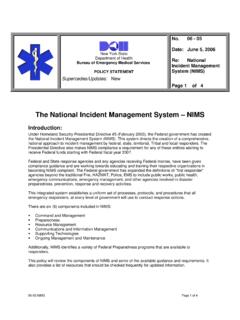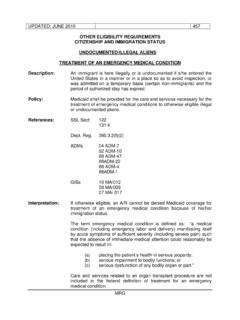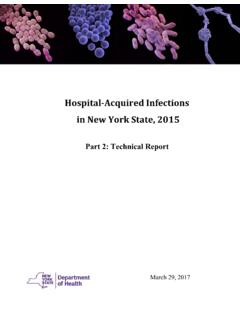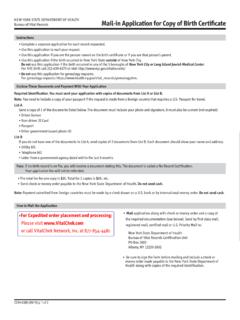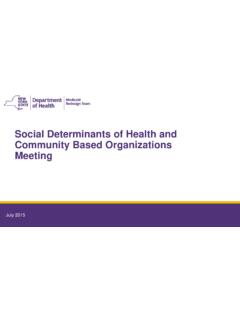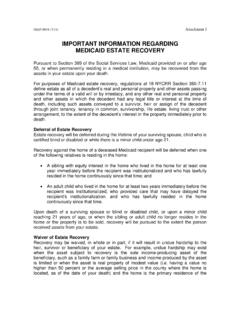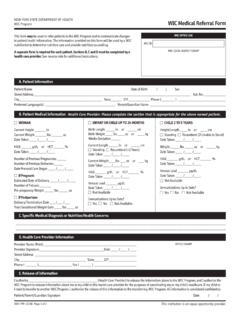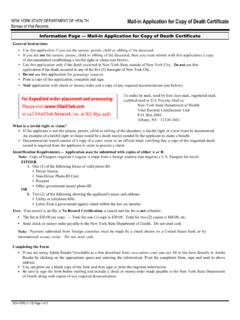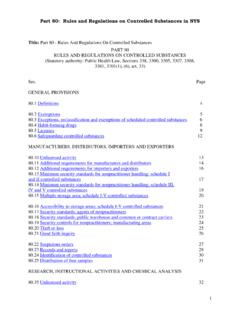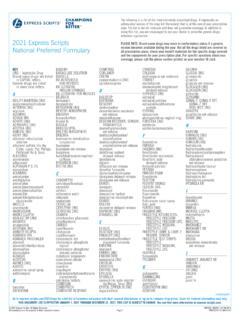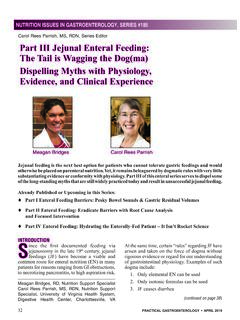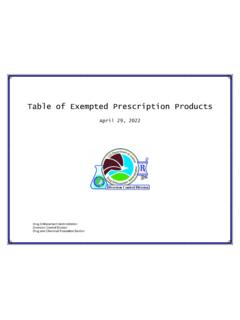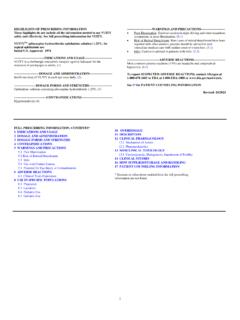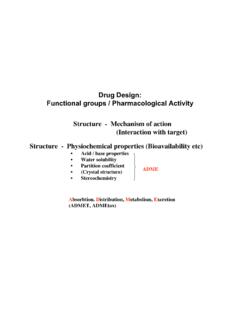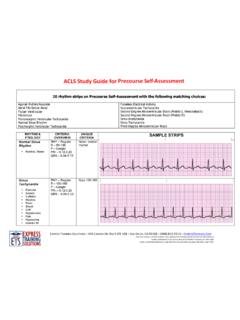Transcription of PEDIATRIC ASSESSMENT TRIANGLE
1 This reference card should not be considered to replace or supercede regional prehospital medical treatment in part by project grant #6 H33 MC 00036 from the Emergency Services for Children program, HRSA, USDHHS in cooperation with NHTSA Rev. 1/04 General Impression (First view of patient)Airway & Appearance (Open/Clear Muscle Tone /Body Position) Abnormal: Abnormal or absent cry or response to parents or environmental stimuli. Floppy or rigid muscle tone or not moving. ABNormal: Normal cry or speech. Respondsto parents or to environmental stimuli such as lights, keys, or toys.
2 Good muscle tone. CMoves extremities well. Circulation to Skin Work of Breathing (Visible movement / Respiratory Effort)Abnormal: Increased/excessive (nasal flaring,retractions or abdominal muscle use) or decreased/absent respiratory effort or noisybreathing. Normal: Breathing appears regular without excessive respiratory muscle effort or audible respiratory sounds. (Color / Obvious Bleeding) Abnormal: Cyanosis, mottling, paleness/pallor or obvious significant bleeding.
3 Normal: Color appears normal for racial group of child. No significant Points: Any abnormal findings or life-threatening chief complaint such as major trauma/burns, seizures, diabetes, asthma attack,airway obstruction, etc (urgent) proceed to Initial ASSESSMENT . Contact ALS if ALS not already on scene/enroute. All findings normal (non-urgent) proceed to Initial ASSESSMENT . Initial ASSESSMENT (Primary Survey) Airway & Appearance (Open/Clear Mental Status)Abnormal: Obstruction to , stridor or noisy , Pain, or Unresponsive on AVPU : Clear and maintainable.
4 Alert on Continue assessmentAVPU scale. throughout transport Breathing (Effort / Sounds / Rate / Central Color) Abnormal: Presence of retractions, nasalflaring, stridor, wheezes, grunting, gasping orgurgling. Respiratory rate outside normalrange. Central cyanosis. Normal: Easy, quiet respirations. Respiratory rate within normal range. No central cyanosis. Circulation (Pulse Rate & Strength / Extremity Color & Temperature / Capillary Refill / Blood Pressure)Abnormal: Cyanosis, mottling, or pallor.
5 Absent or weak peripheral or central pulses; Pulse or systolic BP outside normalrange; Capillary refill > 2 sec with other abnormal : Color normal. Capillary refill at palms, soles, forehead or central body 2 sec. Strong peripheral and centralpulses with regular Action Points: Any abnormal finding (C, U, or P) Immediate transport with ALS. If ALS is not immediately available, meet ALSintercept enroute to hospital or proceed to hospital if closer. Open airway & provide O2. Assist ventilations, start CPR,suction, or control bleeding as appropriate. Check for causes such as diabetes, poisoning, trauma, seizure, etc.
6 Assist patient with prescribed bronchodilators or epinephrine auto-injector, if appropriate. All findings on ASSESSMENT of child normal (S) Continue ASSESSMENT , detailed history & treatment at scene or Respiratory Rate: Normal Pulse Rate: Lower Limit of Normal Systolic BP: Infant (<1yr): 30- 60 Infant: 100-160 Infant: >60 (or strong pulses) Toddler (1-3yr): 24 -40 Toddler: 90-150 Toddler: >70 (or strong pulses) Preschooler(4-5yr): 22- 34 Preschooler: 80-140 Preschooler: >75 School-age(6-12yr): 18 -30 School-age.
7 70-120 School-age: >80 Adolescent(13-18yr): 12 -20 Adolescent: : >90 Pulses slower in sleeping child / athlete Estimated >70 + (2 x age in yr) PEDIATRIC ASSESSMENT This reference card should not be considered to replace or supercede regional prehospital medical treatment in part by project grant #6 H33 MC 00036 from the Emergency Services for Children program, HRSA, USDHHS in cooperation with NHTSA Rev. 1/04 PEDIATRIC CUPS (with examples)Critical Absent airway, breathing or circulation (cardiac or respiratory arrest or severe traumatic injury)Unstable Compromised airway, breathing or circulation (unresponsive, respiratory distress, active bleeding, shock, active seizure, significant injury, shock, near-drowning, etc.)
8 Potentially Normal airway, breathing & circulationUnstable but significant mechanism of injury or illness (post-seizure, minor fractures, infant < 3mo with fever, etc.)Stable Normal airway, breathing & circulation No significant mechanism of injury or illness (small lacerations or abrasions, infant 3mo with fever) Neonatal Resuscitation Dry, Warm, Position, Tactile Stimulation. Suction Mouth then for ALS back-up. Administer O2 as needed. Apnea/Gasping, HR <100 or central cyanosis Ventilate with BVM @ 40-60/min HR<60 after 30 sec BVM Chest Compressions @ 120/min - 3:1 1/3 to 1/2 chest depth 2 thumb encircle chest or 2 fingers ALS available & HR <60 Intubate APGAR ScoreEpinephrine 0 pts 1 pt 2 pts IV/IO/ET Pulse Absent <100 100 1.
9 10,000 Resp Absent Slow Good q 3-5 min Irregular Tone Limp Some Active flexion motion Reflex None Grimace Cough Sneeze Color Blue Pink Body All Blue Limbs Pink ALS Guidelines Asystole or PEA Assess airway & start CPR Intubate & ventilate with oxygen Epinephrine: mg/kg 1:10,000 IV/ IO mg/kg 1:1000 Epinephrine q 3-5 min, same dose Consider hi dose mg/kg 1:1000 IV/IO/ET Consider possibility of hypoxia, hypovolemia, hypothermia, hyper/hypokalemia, tamponade, , toxins/poisons/drugs & treat if present.
10 Glasgow Coma Score Infants Children /Adults Eye Opening Spontaneous 4 Spontaneous To speech/sound 3 To speech To pain 2 To pain No response 1 No response Verbal Response Coos or babbles 5 Oriented Irritable crying 4 Confused Cries to pain 3 Inappropriate words Moans to pain 2 Incomprehensible None 1 None Motor Response Spontaneous .6 Obeys commands Withdraws touch 5 Localizes pain Withdraws pain.
